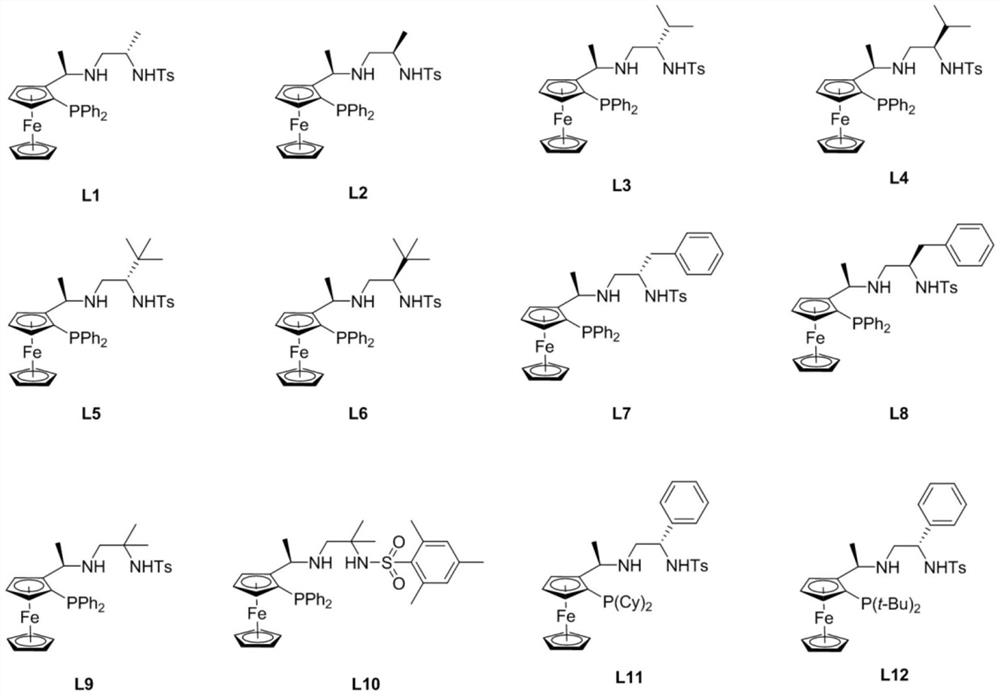Chiral tridentate nitrogen-nitrogen-phosphine ligand and application thereof in asymmetric hydrogenation reaction of ketone
A technology of tridentate nitrogen-nitrogen and phosphine ligands, used in catalytic reactions, organic compound/hydride/coordination complex catalysts, organic chemistry, etc. Ease of use, high reactivity, mild reaction conditions
- Summary
- Abstract
- Description
- Claims
- Application Information
AI Technical Summary
Problems solved by technology
Method used
Image
Examples
Embodiment 1
[0044] Example 1: Synthesis of Ligand L1
[0045]
[0046] p-Toluenesulfonyl chloride (25.17g, 132mmol) and pyridine (12mL) were added to a 250mL flask, L-alaninol (4.51g, 60mmol) and pyridine (4mL) were added to the dropping funnel, and slowly added dropwise to the system , and stirred at room temperature for 16 h. Acetic acid (6 mL), ice (60 g), and water (120 mL) were added to quench the reaction, ethyl acetate was added, and 2M aqueous hydrochloric acid was added to the system to neutralize pyridine until no more pyridine remained, extracted with ethyl acetate, and the organic phases were combined. , washed with saturated brine, dried over anhydrous sodium sulfate, evaporated to remove the solvent, and recrystallized with n-hexane and ethyl acetate to obtain 17.46 g of a pale yellow solid with a yield of 76%.
[0047]
[0048] Compound 8 (11.50 g, 30 mmol) was dissolved in toluene (120 mL), 20% KOH aqueous solution (180 mmol, 50.5 g solution) was added dropwise, and...
Embodiment 2
[0057] Example 2: Synthesis of Ligand L4
[0058]
[0059] p-Toluenesulfonyl chloride (25.17 g, 132 mmol) and pyridine (12 mL) were added to a 250 mL flask, D-valinol 14 (6.19 g, 60 mmol) and pyridine (4 mL) were added to the dropping funnel, and slowly added dropwise The system was stirred at room temperature for 16h. Acetic acid (6 mL) was added, ice water (120 mL) was added to quench the reaction, ethyl acetate was added, and 2M aqueous hydrochloric acid was added to the system to neutralize pyridine until there was no pyridine residue, extracted with ethyl acetate, the organic phases were combined, and saturated brine Washed, dried over anhydrous sodium sulfate, evaporated to remove the solvent, and recrystallized with n-hexane and ethyl acetate to obtain 18 g of a pale yellow solid with a yield of 73%.
[0060]
[0061] Compound 15 (12.35 g, 30 mmol) was dissolved in toluene (120 mL), 20% KOH aqueous solution (180 mmol, 50.5 g solution) was added dropwise, and the ...
Embodiment 3
[0066] Example 3: Synthesis of Ligand L9
[0067]
[0068]Compounds 13 (228 mg, 0.5 mmol) and 18 (242 mg, 1.0 mmol) were refluxed in anhydrous MeOH (2 mL) overnight under nitrogen atmosphere, and the solvent was evaporated in vacuo to give the crude product. After chromatography on a silica gel column using petroleum ether / ethyl acetate (v / v)=20:1 to 3:1 as an eluent, 169 mg of a yellow solid was obtained with a yield of 53%. 1 H NMR (600MHz, CDCl 3 )δ7.81-7.64(m,2H),7.53(ddd,J=9.6,4.9,2.2Hz,2H),7.43-7.34(m,3H),7.25-7.16(m,7H),5.57(s, 1H), 4.46(p, J=1.6Hz, 1H), 4.32(t, J=2.5Hz, 1H), 4.05(dd, J=6.6, 2.8Hz, 1H), 4.00(s, 5H), 3.83( dt, J=2.4, 1.1Hz, 1H), 2.41(s, 3H), 2.11(s, 2H), 1.42(d, J=6.5Hz, 3H), 0.72(s, 3H), 0.59(s, 3H) ). 13 C NMR (151MHz, CDCl 3 )δ142.37,140.92,139.92(d,J=10.1Hz),136.96(d,J=9.0Hz),135.00,134.86,132.65,132.53,129.29,129.15,128.47,128.43,128.15,128.29(d,128.90. ,J=24.6Hz),74.98(d,J=7.6Hz),71.42(d,J=5.0Hz),69.71,69.36(d,J=4.6Hz),69.14,57.05,55.23,50...
PUM
 Login to View More
Login to View More Abstract
Description
Claims
Application Information
 Login to View More
Login to View More - Generate Ideas
- Intellectual Property
- Life Sciences
- Materials
- Tech Scout
- Unparalleled Data Quality
- Higher Quality Content
- 60% Fewer Hallucinations
Browse by: Latest US Patents, China's latest patents, Technical Efficacy Thesaurus, Application Domain, Technology Topic, Popular Technical Reports.
© 2025 PatSnap. All rights reserved.Legal|Privacy policy|Modern Slavery Act Transparency Statement|Sitemap|About US| Contact US: help@patsnap.com



